Retail India - Retail India News: Just Herbs Collabs with Athiya ...
7 Common Causes Of Inner Knee Pain And How To Treat It
The inside of your knee can hurt for many reasons, but it often occurs due to cartilage deterioration. It can also follow a sports injury or trauma to your knee.
Knee pain is common and can be a symptom of many knee conditions or injuries. The inside of your knee, also called the medial knee or the medial compartment, is the area of the knee that's closest to your opposite knee.
Your knee consists of the intersection of four bones, four ligaments, several tendons, two menisci, and cartilage. It is easily injured because it's one of the most complex joints in the body.
Knee pain often occurs due to an injury. Some common incidents that cause knee injury and pain include:
Here are seven common causes of inner knee pain.
Osteoarthritis (OA) is a degenerative disease that breaks down cartilage, causing the bones in your joints to grind together.
If you experience inner knee pain while putting pressure on your joint, such as when walking up and down stairs or sitting down in a chair, you may have OA. Because this pressure causes the pain, your symptoms may get worse as the day goes on.
This typically happens in people with a varus knee. Over time, this condition causes wear and tear on the cartilage, leading to osteoarthritis.
Rheumatoid arthritis (RA) is an autoimmune disease that causes joint pain, swelling, and stiffness. It can cause inner knee pain, but people with RA typically have pain throughout the entire joint rather than just the inner knee.
RA causes inflammation in your joints, so people with RA may experience severe knee pain in the morning, with symptoms decreasing throughout the day.
The medial collateral ligament (MCL) runs along the outside of your inner knee to stabilize the joint. If the ligament overstretches, you may have an MCL sprain.
The MCL can also tear partially or fully. An MCL injury most commonly occurs after force is applied to the outer knee, such as in contact sports.
Symptoms of an MCL injury include:
The meniscus is cartilage that provides a cushion between bones in a joint. There are two menisci in each knee. They serve as cushions between your thigh and shin bones.
Your meniscus can tear or become damaged if your knee is rotated or put under pressure, most commonly during sports or athletic activities.
There are four major types of meniscus tears:
Depending on the severity of the injury, you may also feel:
A bursa is a small, fluid-filled sac that helps reduce friction between muscles and ligaments. There are several bursae located throughout your body.
Bursae are also located in your knees between the MCL and three tendons: the sartorius, gracilis, and semitendinosus. They're collectively called the pes anserinus.
If the bursa becomes overused or irritated, it can produce extra fluid that causes swelling and pressure on your knee. This inflammation is known as pes anserine bursitis.
According to the American Academy of Orthopaedic Surgeons, causes of pes anserine bursitis can include:
Plica are small folds in the joint lining. Medial plicae cover your inner knee. Overuse, such as from repeatedly flexing your knee, can irritate the medial plicae, causing plica syndrome.
This causes the folds to thicken and become stuck between the bones. In addition to dull inner knee pain, you may experience locking knees and possibly a cracking sound.
If you experience a direct blow to your knee, such as being hit by a blunt object or falling hard, you could bruise your knee bone. This is also known as a knee contusion.
A knee contusion could cause inner knee pain, depending on where you were hit. Other symptoms of knee contusions include:
Injuries can also cause other conditions that affect the knee. These can include:
Knee injuries are fairly common, and many can be resolved at home.
If you have symptoms for more than three days, you may have an injury that needs medical attention. Doctors may recommend more involved treatment methods depending on the cause of your pain.
Home remediesMinor knee pain is common and can often be treated at home.
Most experts recommend that you:
You may also take nonsteroidal anti-inflammatory drugs such as ibuprofen (Advil) to relieve swelling if recommended by a doctor. If symptoms persist after three days despite this treatment or if your pain worsens, consider talking with a doctor.
Other inner knee pain treatmentsIf your inner knee pain is severe, worsens after several days, or if basic at-home remedies don't help your symptoms, consider seeing a doctor or going to an orthopedic immediate care center.
Some treatment methods for more serious knee injuries include:
While not all causes of inner knee pain are preventable, doctors and physical therapists recognize strengthening the leg muscles, specifically the quadriceps and hamstrings, as one of the most effective ways to treat and prevent knee injury.
Helpful exercises may include:
In addition, you should always begin and end exercising of any kind by gently stretching all the muscles involved, especially the quadriceps and hamstrings. Check out these quad and hamstring exercises to strengthen bad knees.
The following includes common questions about pain affecting the inner knee.
What causes pain in the inner side of knee?You may experience medial knee pain due to injury or another health condition, such as osteoarthritis or rheumatoid arthritis. Injury can damage the surrounding tissue and joints. You can tear or strain the medial collateral ligament or meniscus.
How do you treat inner knee pain?Doctors may recommend different treatments for inner knee pain depending on the cause. Common treatments include physical therapy, medication to reduce swelling, ice therapy, and exercise.
Is inner knee pain serious?Inner knee pain may be serious if it is severe or lasts longer than a few days. In some cases, an injury may resolve on its own with at-home care. Other times, you may need medical care to manage or relieve your symptoms.
What tendon hurts on the inner side of knee?A strained or torn pes anserinus tendon may cause pain in the inner knee. This can happen due to injury.
Pain may also occur if there is damage to the medial collateral ligament that runs along the outside of your inner knee and stabilizes your joint.
You may develop inner knee pain due to a health condition like osteoarthritis or a sudden injury. Sometimes, when and where the symptoms occur may help pinpoint the cause.
If you have pain on the inner side of your knee, it may resolve with at-home care, including ice and gentle stretching. In some cases, you may need treatment like physical therapy, injections, or surgery, depending on the cause and severity.
Do These 10 Knee-strengthening Exercises At Home To Reduce Pain And Improve Mobility
Welcome to Start TODAY. Sign up for our Start TODAY newsletter to join the 30-day challenge and receive daily inspiration sent to your inbox.
Many Start TODAY members complain about knee pain inhibiting their ability to commit to a walking routine. I know how frustrating it can be to feel sidelined by pain when you're otherwise motivated to workout!
But it's no surprise that pain in the knees is so debilitating. The knees play a crucial role in all aspects of movement — not only during our workouts, but in our daily routines as well. So when you suffer from knee pain, it can really affect your ability to move comfortably. With knee injuries or weak knees, it can be hard to do even simple movements like walking.
You may be surprised to learn that in order to reduce the stress put on the knees, you actually need to strengthen other muscles. Specifically, strengthening the glutes, quadriceps, hamstrings and calves is essential. Each of these muscles supports the knee joint, reducing the likelihood of injury.
From arthritis to injuries that've occurred from sports-related activities, movements that tone these muscles around the knee joint are the best way to not only strengthen the knees, but to prevent any further injuries.
10 knee-strengthening exercisesHere are 10 exercises you can do at home to strengthen the knees and reduce pain.
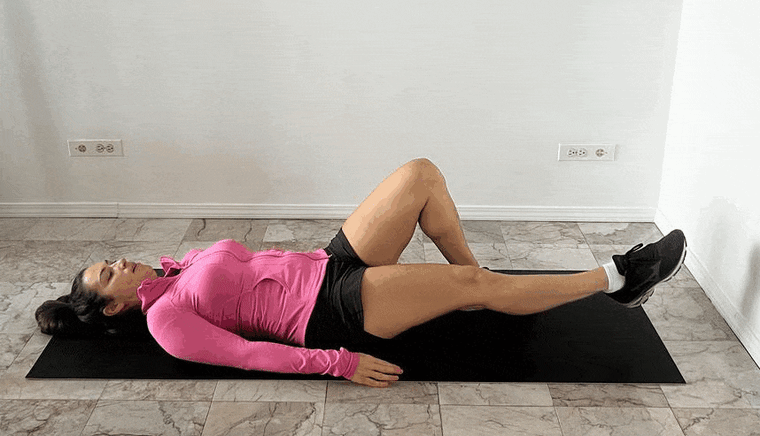 Straight leg raises
Straight leg raises This easy knee-strengthening exercise is the perfect starter exercise. It engages the quadriceps, which stabilize the knee joint during movement. To start, lie down on your back. Bring one leg in by bending the knee and setting your foot flat on the floor. The other leg should be kept straight out in front of you. Keeping the bent leg still, raise the straight leg to the height of the bent knee. Point the foot and squeeze the quad. Repeat 10 times and then switch legs.
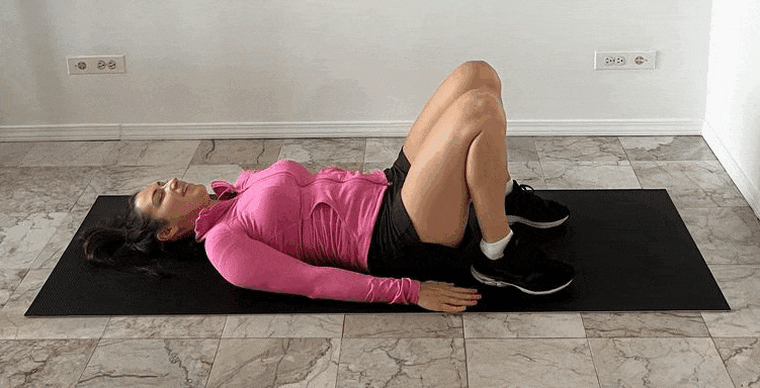 Glute bridges
Glute bridges Lie on your back on a flat surface. Pull your knees in toward your body to a comfortable bent position with both feet flat on the ground. Pressing through your heels, peel your low, mid then upper back off the floor to raise your glutes off the ground. Pull the abs in to support the lower back. At the top position, squeeze the glutes before slowly returning back to the start position. Repeat 10 times.
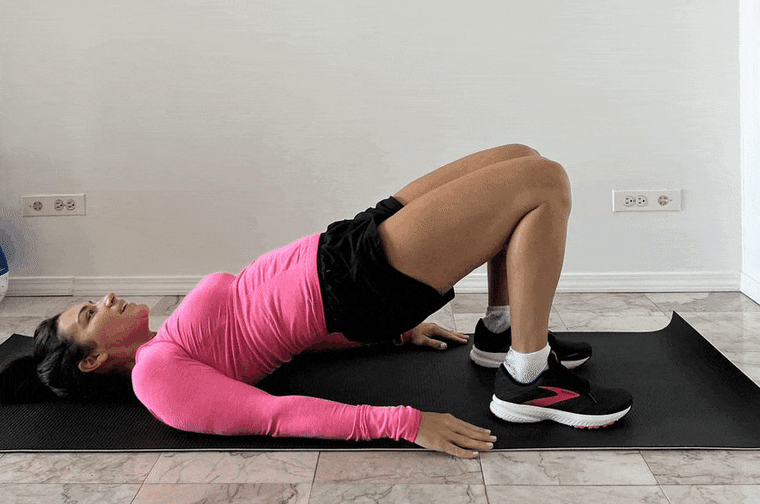 Marching glute bridges
Marching glute bridges Lie on your back with bent knees and feet hips-width apart. Relax your arms by your sides. Pull the navel in toward the spine as if you're zipping into a tight pair of pants. Slowly roll the hips up, then low back, then mid-back off the ground. Press down through the feet, then lift the right foot off the ground as if you're beginning to march. Return the right foot to the ground and then lift your left foot. Keep the hips steady as you lift each foot off the ground. You can place your hands on your hips to ensure that they are staying stationary. March five times per foot.
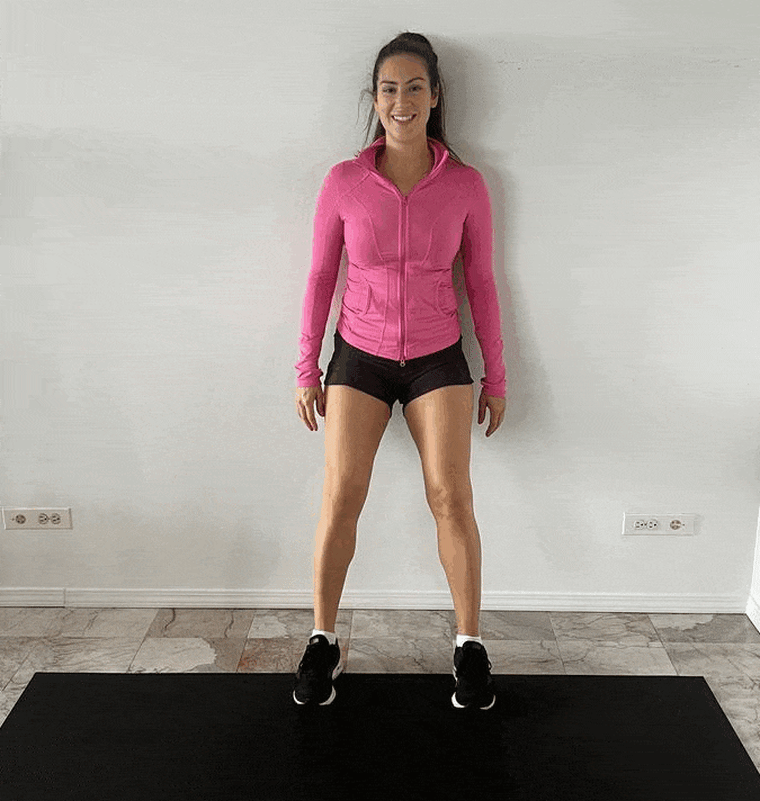 Wall sit
Wall sit Used to build endurance in the glutes, quadriceps and calves, the wall sit is another great knee-strengthening exercise. In an open space on a clear wall, sit back against the wall and slide down into a squat until you form a 90-degree angle with your hips and knees. Keeping your back flat against the wall, hold this position for 10 seconds. Complete three wall sits total.
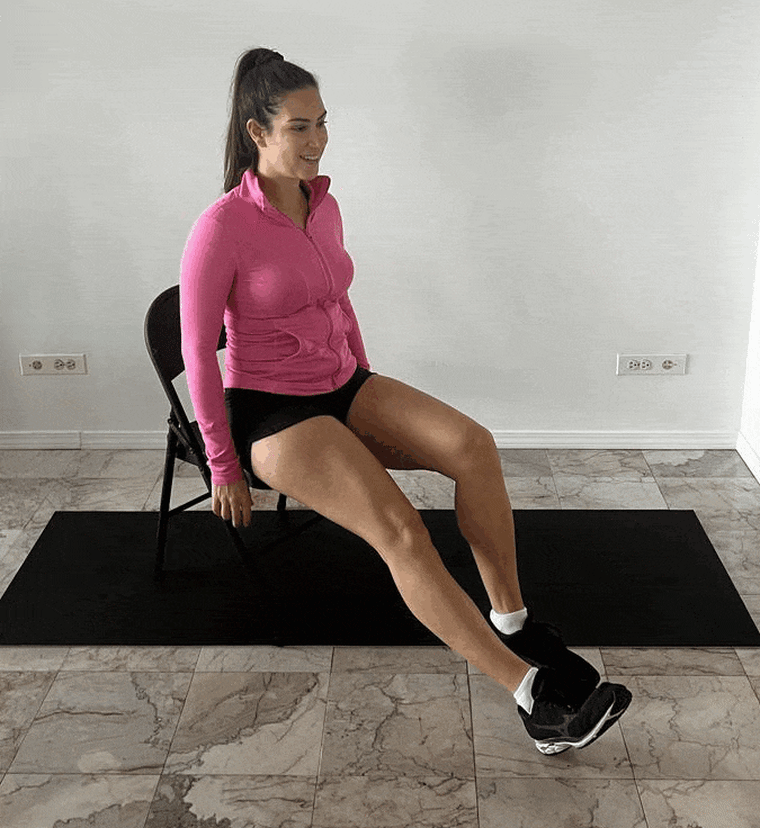 Seated leg raises
Seated leg raises To complete this knee-strengthening exercise, start by sitting on a chair with both knees bent. Keeping one foot on the ground, engage the other leg by straightening the leg out in front of you, squeezing the quad and flexing the foot. Then slowly raise the leg until it is parallel to the floor. Pause, then slowly return the leg to starting position. Repeat 10 times and then switch legs.
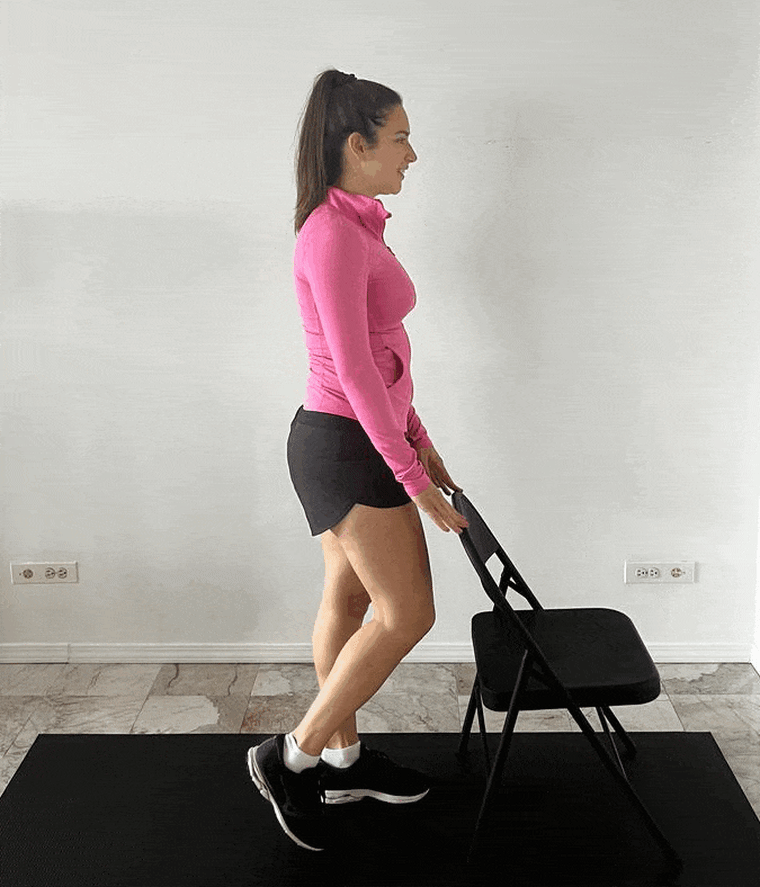 Standing hamstring curl
Standing hamstring curl Using a chair or wall for support, start in a standing position. Pick one leg up and raise it off the floor by bending the knee to a 90-degree angle. Hold for two seconds before returning to the starting position. Repeat 10 times and then switch legs.
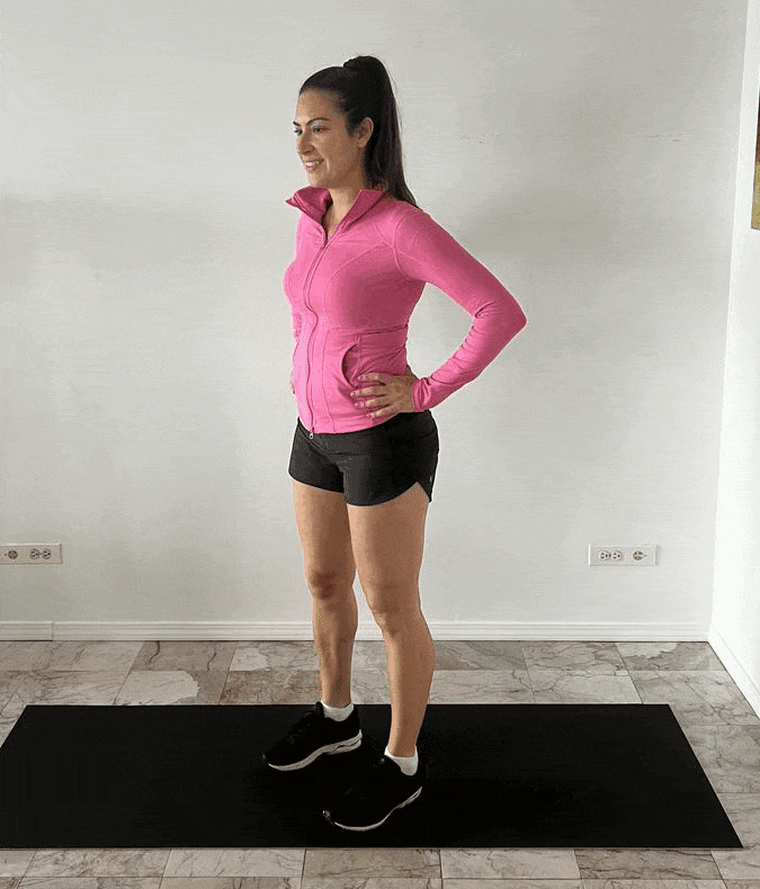 Half squat
Half squat A half squat is a great way to strengthen your glutes, hamstrings and quadriceps without putting too much strain on your knees. Start off in a standing squat position with feet shoulder-width apart. Place your hands on your hips or extend your arms straight out in front of you to maintain an upright torso. Pull your naval in toward your spine. Slowly squat down to the halfway point of a full squat. Pause to increase muscle tension, then raise back up to a standing position. Repeat 10 times.
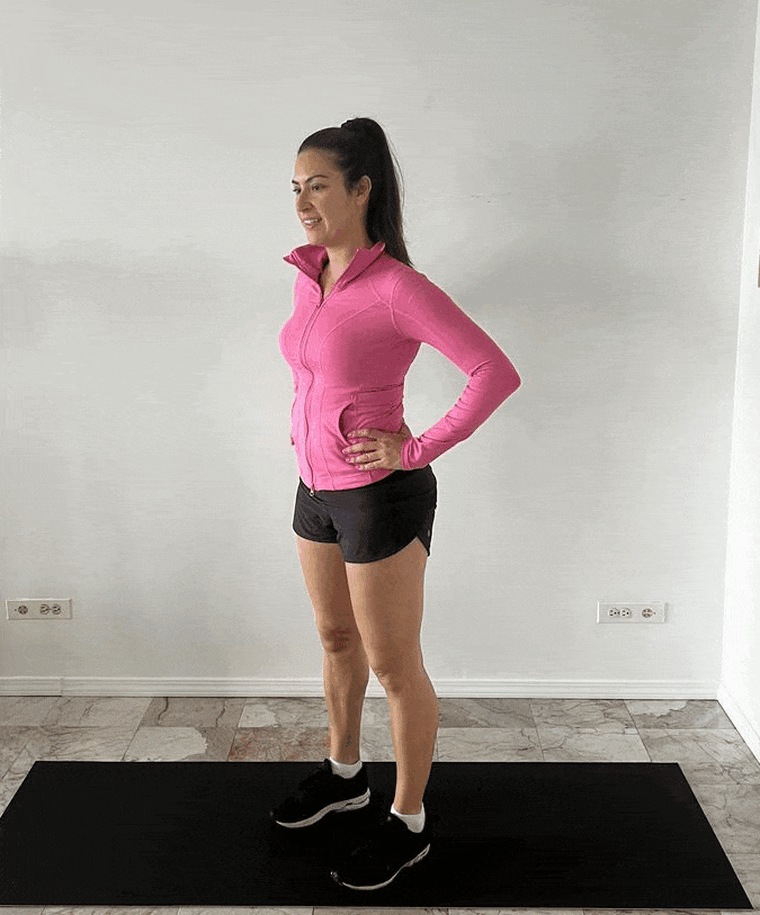 Calf raises
Calf raises Stand with your feet shoulder-width apart (near a wall or chair for stability if needed). Raise both heels off of the ground to stand on the balls of your feet. Slowly return back to a standing position. Repeat 10 times.
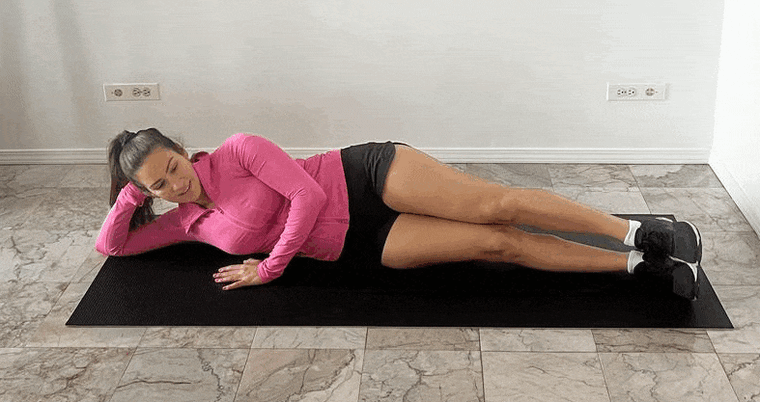 Side leg raises
Side leg raises Lie down on your side on a flat surface. Both legs should be straight, stacked on top of each other. Raise the top leg as high as you are comfortable with; pause at the top. Slowly lower your leg to return to the starting position. Repeat 10 times and then flip over to the other side and switch legs.
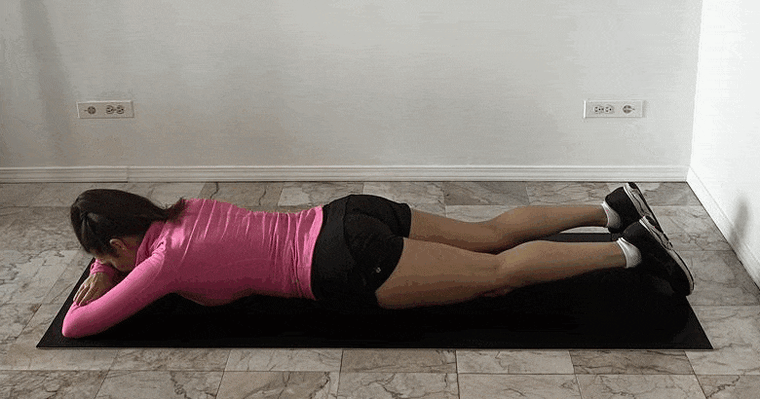 Prone leg raises
Prone leg raises Lie face down on a flat surface. Rest your head on your forearms with both legs straight out behind you. Starting with one leg, engage your hamstrings and glutes to raise your leg as high as you are comfortably able to. Then slowly return back to the starting position. Repeat 10 times and then switch legs.
Stephanie MansourKnee Pain Relief In Just 15 Minutes Using Heat And Infrared Light Therapy And Massage
We all know how debilitating knee pain can be. If you are suffering from arthritis or injury and are looking for an easy way to obtain knee pain relief, you might be interested in a new 3-in-1 device called Kneeflow. Launched via Indiegogo this month, Kneeflow is an innovative home therapy system that uses infrared light and heat therapy combined with massage, to bring relief to those suffering from chronic knee pain, from athletes to those with arthritis.
Early bird pricing is now available for the innovatory project from roughly $115 or £98 (depending on current exchange rates), offering a considerable discount of approximately 53% off the retail market price, while the Indiegogo crowdfunding is underway.
Imagine a life where you no longer have to endure the discomfort of knee pain. Kneeflow has been designed to provide relief from knee pain in as little as 15 minutes. Kneeflow employs a 3-in-1 therapeutic approach to offer you long-lasting relief from pain.
Kneeflow Heat therapyThese distinctive features aim to address knee pain at its roots, rather than providing a temporary fix. The flexible design can be customized to address your personal needs and situation. For instance, you might be recovering from surgery, dealing with chronic pain, seeking relief after exercise, or attempting to get ahead of your pain. Kneeflow is a versatile solution and features three vibration massage settings:
The compact and cordless design makes Kneeflow an ideal companion for the office, on a trip, during training sessions, or just for use at home. Navigating Kneeflow is a breeze thanks to its LCD touchscreen display. Kneeflow also features an adjustable Velcro strap allowing it to be easily fitted, ensuring a perfect fit every time.
Other features include an active ventilation system, overheating protection, and a 15-minute auto shut-off timer, all contributing to your peace of mind. If the Kneeflow campaign successfully raises its required pledge goal and production progresses smoothly, worldwide shipping is expected to take place sometime around December 2023.
The co-founder of Kneeflow, Nida, knows all too well the life-altering impacts of chronic knee pain. This personal experience fueled the creation of Kneeflow, resulting from extensive research and dedication to finding a lasting solution to knee pain. The result is an effective, cost-friendly device that provides more than just temporary relief.
Remember, knee pain should not imprison you within your own body. It's time to take back control and return to the life you deserve. With Kneeflow, you can do just that! Watch this informative video below from Dr. Greg Donadio, a renowned Doctor of Naprapathic Medicine, to learn more about the benefits of Kneeflow.
In the video above Dr. Greg Donadio discusses Kneeflow which he has been using for knee injuries. Explaining that Kneeflow is a platelet-rich plasma treatment that uses the body's own healing factors to promote healing in the joints. He explains that using Kneeflow in the morning can help warm up the muscles and increase blood flow, making your muscles more prepared for exercise or daily activities. He also notes that using Kneeflow can be beneficial for those who live in cold weather areas or who suffer from inflammation.
Kneeflow is not only perfect for preventive care but also helpful for individuals with arthritis and can be used to warm up the knees before physical activity. Using this device for 15 minutes prior to a workout can help prevent injuries.
In summary, Kneeflow is a unique treatment that harnesses the power of platelet-rich plasma. This innovative approach utilizes the body's own healing factors to promote recovery in the joints. It's a natural solution that works in harmony with your body's processes, making it a safe and effective option for many individuals.
If you are wondering how to incorporate Kneeflow into your routine, simply follow the steps below. The massager is designed to be user-friendly, making it easy for anyone to use.
Incorporating Kneeflow into your morning regime can help warm up your muscles and boost blood circulation. This preparation makes your muscles more ready for exercise or your daily activities. It's like a gentle wake-up call for your joints, ensuring they're ready to take on the day.
Kneeflow is also specifically designed for post-exercise making it an ideal companion following sports, gym sessions, or any physically demanding activity to aid in knee rehabilitation, recovery and rejuvenation. Kneeflow has been extensively beta tested undergoing clinical trials and receiving encouraging feedback from UFC and NBA athletes. Who have been using Kneeflow post-game and after surgery.
If you live in a cold-weather area or struggle with inflammation, you will be pleased to know that Kneeflow can be particularly beneficial. The device's warming effect can help counteract the stiffness often associated with cold weather or inflammation, making it easier to move around and carry out your daily tasks.
ConclusionKneeflow is a versatile and effective tool for anyone looking to improve their joint health. Whether you're recovering from an injury, living with arthritis, or simply looking to prevent future issues, Kneeflow could be the solution you've been looking for.
Rediscover the freedom of movement with Kneeflow, an innovative, at-home, 3-in-1 massage therapy device. Combining soft massage airbags, infrared light, and heat therapy, Kneeflow provides personalized therapeutic experiences for anyone suffering from knee pain.
This unique device, is adjustable to individual needs, portable and user-friendly, and has been specifically designed to rejuvenate knee cells, stimulate blood circulation, and alleviate inflammation, swelling, and pain. Its infrared technology and heat settings offer deep tissue therapy while ensuring comfort and safety. Relieve chronic knee pain and reclaim your active lifestyle with Kneeflow, your key to recovery, rejuvenation.
For a complete list of all available backing options, stretch goals, extra media, and operational specifications for the Kneeflow pain relief system, jump over to the official Kneeflow crowdfunding campaign page.
Source: Indiegogo
Filed Under: Design News, Technology News, Top NewsLatest Geeky Gadgets Deals
Disclosure: Some of our articles include affiliate links. If you buy something through one of these links, Geeky Gadgets may earn an affiliate commission. Learn about our Disclosure Policy.


Comments
Post a Comment